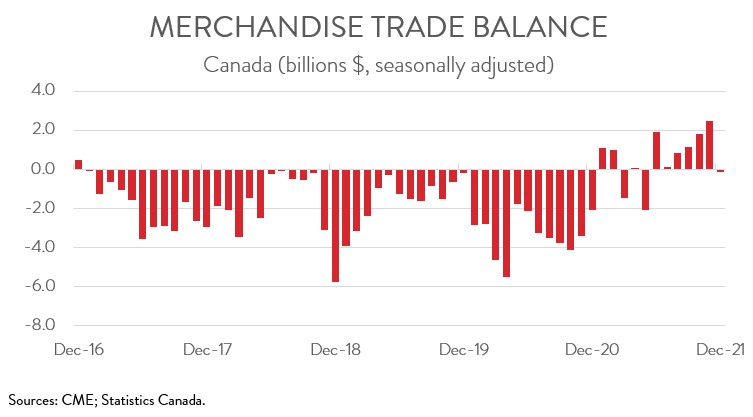International Trade
Merchandise Trade
December 2021
Canada Posts First Trade Deficit in Seven Months, as Exports Edge Down
HIGHLIGHTS
- Canadian merchandise exports fell 0.9% to $57.6 billion in December, while merchandise imports jumped 3.7% to $57.7 billion.
- Canada’s merchandise trade balance slipped back into a deficit of $137.5 million in December from a surplus of $2.5 billion in November.
- After removing price effects, export volumes were down 0.2%, while import volumes were up 3.1%.
- The decrease in exports spanned 5 of 11 major commodity groups, driven by a substantial decline in the exports of energy products.
- Exports to the U.S. fell 1.4% to $44.3 billion in December, while exports to the rest of the world rose 0.6% to $13.3 billion.
- Despite persistent global supply chain disruptions, both exports ($637 billion) and imports ($631 billion) reached record highs in 2021. As well, Canada posted its first annual surplus ($6.6 billion) since 2014 and the largest since 2008. Still, trade activity is likely to remain bumpy over the near term, as manufacturers continue to grapple with labour shortages and supply chain disruptions, including those related to recent border protests.
EXPORTS EDGE DOWN 0.9% IN DECEMBER, WHILE IMPORTS JUMP 3.7%
Canadian merchandise exports fell 0.9% to $57.6 billion in December, while merchandise imports jumped 3.7% to $57.7 billion. In volume terms, the picture was largely unchanged: real exports were down 0.2% and real imports were up 3.1%.

Despite persistent global supply chain disruptions, both exports ($637 billion) and imports ($631 billion) reached record highs in 2021. While export prices and import prices rose last year, the increase in export prices was substantially stronger, and this helped Canada post its first annual surplus ($6.6 billion) since 2014 and the largest since 2008. Still, trade activity is likely to remain bumpy over the near term, as manufacturers continue to grapple with labour shortages and supply chain disruptions, including those related to recent Canada-U.S. border protests.
CANADA RECORDS FIRST TRADE DEFICIT IN SEVEN MONTHS
Canada’s merchandise trade balance slipped back into a deficit of $137.5 million in December from a surplus of $2.5 billion in November, the first monthly deficit since May 2021. Breaking these data down, Canada’s trade surplus with the U.S. narrowed from $9.5 billion in November to $8.1 billion in December, while our trade deficit with the rest of the world widened from $7.0 billion to $8.2 billion.

DECREASE IN EXPORTS DRIVEN BY ENERGY PRODUCTS
The decrease in exports spanned 5 of 11 product categories. Exports of energy products fell 5.9% to $13.6 billion in December, the first monthly decline since April. Crude oil exports contributed the most to the decrease, due to a sharp drop in prices. At the same time, coal exports fell for the second month in a row, as November’s floods continued to disrupt freight transport in B.C. Despite the tough end to the year, exports of energy products surged 82.8% on an annual basis in 2021, the largest annual increase among all product categories.
On the other hand, non-energy exports were up 0.7% in December. Consumer goods led the way, with exports rising 4.3% to $7.5 billion, attributable to higher exports of pharmaceutical products. In November, large shipments of medication for the treatment of COVID-19 arrived in Canada for packaging and labelling, and some of this medication was subsequently exported in both November and December.
In addition, exports of motor vehicle and parts climbed 4.7% to $6.7 billion in December, the third consecutive monthly increase. But despite the fourth quarter recovery, annual exports of motor vehicles and parts in 2021 were down 4.3% compared to 2020 and down 23.6% compared to 2019.

LOWER EXPORTS TO THE U.S. PARTLY OFFSET BY HIGHER EXPORTS TO THE REST OF THE WORLD
Exports to the U.S. fell 1.4% to $44.3 billion in December, the first decline in three months, while exports to the rest of the world rose 0.6% to $13.3 billion. Among Canada’s major non-U.S. trading partners, exports to China, South Korea and Japan were down, while exports to the European Union, the United Kingdom, and Mexico were up. The decline in exports to China was attributable to lower exports of canola and coal. Higher exports of gold drove the increase in exports to the U.K.
